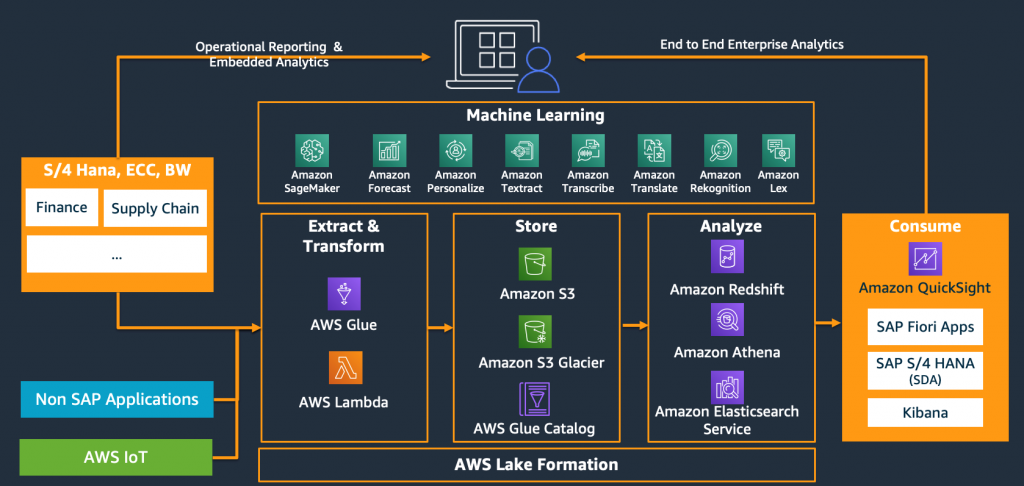AWS for SAP
Tag: SAP
How to integrate Amazon WorkSpaces with SAP Single Sign-On
SAP Single Sign-On allows users to have secure access to SAP and non-SAP systems using centralized authentication whether the systems are on-premises or in the cloud. SAP Single Sign-On provides the simplicity to manage users’ authentication, secure data communication, and integrate with two-factor and risk-based authentication. This includes possession of mobile phone and RSA SecurID […]
How to use snapshots for SAP HANA database to create an automated recovery procedure
In this blog post, we describe a cloud native approach to demonstrate the power and capabilities of AWS. There are still good reasons for HANA System Replication (HSR) or third-party cluster software to build productive systems in cloud environments. However, we focus on an alternative approach by using cloud native features, such as Amazon EC2 Auto Scaling and Amazon Elastic Block Store (EBS) Snapshots. With these features we build an infrastructure with native backup/restore functionality, automated processes, and the focus of low costs, for non-critical SAP applications.
Ensuring reliability and availability of your SAP applications
In a recent survey, 47% of respondents said that running SAP applications on the cloud was an important part of their IT strategy. Your business may be considering a cloud migration for your SAP workloads but you have questions around security, reliability and availability, compliance and governance, cost, and strategy.
Tagging recommendations for SAP on AWS
In this post, we outline the benefits of tagging and provide recommendations for customers and partners deploying SAP workloads on AWS. Recommended tags are based on practices we’ve seen across a number of our engagements. Customers can directly use all of these tags or modify them to fit their own needs.
Red Hat Enterprise Linux (RHEL) high availability for SAP NetWeaver and HANA on AWS
One of the key things customers look for when deploying SAP workloads on AWS is having high availability (HA) set up for their business/mission-critical SAP applications. In this blog post, we discuss the HA option for customers running their SAP workloads on Red Hat Enterprise Linux (RHEL).
Why PFC Brakes and Change Healthcare migrated SAP systems to AWS Cloud
The deadline to move to SAP S/4HANA was recently extended to 2027. Many companies are in the early stages of evaluating how and when to make this upgrade. For many organizations, the decision to adopt the cloud for their enterprise deployments is in the rear view mirror. Thus, migrating SAP to the cloud first, and then pursuing the upgrade to S/4HANA later, may be the best course of action for your company.
Five keys to a successful SAP migration on AWS
Regardless of industry, your customers have more choices than ever. To stay competitive you must meet their needs more quickly, more accurately, and with higher quality. We learned through experiences like that of Joerns Healthcare and other customer engagements that there are five keys to SAP transformation success on AWS.
AWS Transfer for SFTP for SAP file transfer workloads – part 2
Part 1 of this series demonstrated how to integrate SAP PI/PO systems with AWS Transfer for SFTP (AWS SFTP) and how to use the data that AWS SFTP stores in Amazon S3 for post-processing analytics. This post shows you how to integrate SAP Cloud Platform Integration (SAP CPI) with AWS SFTP and use the AWS […]
Using AWS to enable SAP Application Auto Scaling
With AWS Auto Scaling, you only pay for what you require, helping to reduce operational cost and providing higher service level objectives. Gone are the days of calculating how many application servers you require to over-provision to stay above the SAPS calculated for your new project or the upcoming marketing campaign over the weekend.
Building data lakes with SAP on AWS
Customers are looking at ways to tap into SAP data along with non-SAP application data. They want real-time streaming data generated by internet-powered devices to build data and analytics platforms on AWS. In this post, I cover various data extraction patterns supported by SAP applications. I also cover reference architectures for using AWS services and other third-party solutions to extract data from SAP into data lakes on AWS.









